 |
|||||||||||||||||||||||||||||||||||||||||||
|
“This is the season of lists
and callow hopefulness”
|
|||||||||||||||||||||||||||||||||||||||||||
|
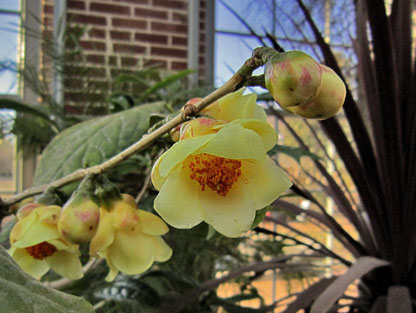 A rare yellow camellia that’s unhurried about blooming has finally bloomed. This yellow camellia is blooming in an oversized pot on the sunny south side of the Linnaean glasshouse. The botanical garden says this camellia - Camellia petelotii - that some call the Golden Camellia - grows wild in southern China and in the forests of Vietnam. It was first introduced as an ornamental shrub in the 70s, but is now a protected species so it can’t be picked in the wild, sold, imported or exported without extensive paperwork. Even though it has an attention grabbing color, it doesn’t seem to have made much of a splash among camellia growers. After watching it for several years, I think I know some of the reasons. It doesn’t produce many flowers so the wow-factor of seeing a tree brimming with camellias just isn’t there with this yellow. Then too it isn’t a consistent, reliable bloomer. Some years it flowers, others not. Who (orchid growers excepted) wants to care for a plant all year long and get nothing in return? I would have thought that those negatives could be fixed by crossing the petelotti with better behaving camellias. But according to the botanical garden, yellow-flowered camellias don’t hybridize well. So yellow plus red equals a smashing orange camellia isn’t in the cards. 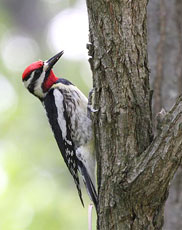 Take a look at what a yellow-bellied sapsucker posted on Wikipedia looks like. Until I saw this picture I thought a sapsucker was some kind of exotic yellow bird that only birdwatchers would ever see. It’s just a woodpecker though and from a distance it looks a lot like many of the ones I’ve seen poking at the suet cakes in my backyard. Take a look at what a yellow-bellied sapsucker posted on Wikipedia looks like. Until I saw this picture I thought a sapsucker was some kind of exotic yellow bird that only birdwatchers would ever see. It’s just a woodpecker though and from a distance it looks a lot like many of the ones I’ve seen poking at the suet cakes in my backyard.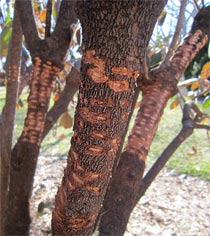 I’ve seen the trademark of these birds before in this botanical garden. Eight years ago about this time of year I noticed their distinctive markings on some white birch trees. Last time I checked into the habits of these birds I found out that they winter here until April. And unlike other woodpeckers that look for dead trees to drill, the yellow-bellied sapsuckers like live ones so that their holes will draw the sap that they feed upon. This morning I saw the birds’ distinctive banded markings on most of the upright branches of the patch of leatherleaf viburnum (Viburnum rhytidophyllum) growing near the entrance to the Chinese Garden. Unlike the round puncture holes I saw on the white birch trees, the scaring on these viburnums was more rectangular. Experts at the University of Arkansas extension service that rectangular drillings are shallower that round ones. That’s good news for the viburnum I guess, but the branches aren’t very thick to begin with. Will all the pecking kill that patch? Likely not, experts say. But the damage may weaken the shrubs leaving them vulnerable to diseases and insects. I’ve seen the trademark of these birds before in this botanical garden. Eight years ago about this time of year I noticed their distinctive markings on some white birch trees. Last time I checked into the habits of these birds I found out that they winter here until April. And unlike other woodpeckers that look for dead trees to drill, the yellow-bellied sapsuckers like live ones so that their holes will draw the sap that they feed upon. This morning I saw the birds’ distinctive banded markings on most of the upright branches of the patch of leatherleaf viburnum (Viburnum rhytidophyllum) growing near the entrance to the Chinese Garden. Unlike the round puncture holes I saw on the white birch trees, the scaring on these viburnums was more rectangular. Experts at the University of Arkansas extension service that rectangular drillings are shallower that round ones. That’s good news for the viburnum I guess, but the branches aren’t very thick to begin with. Will all the pecking kill that patch? Likely not, experts say. But the damage may weaken the shrubs leaving them vulnerable to diseases and insects.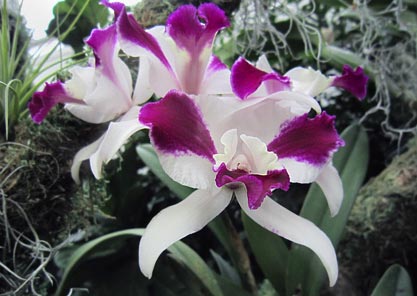 Another visit to the orchid show -- here’s my favorite this week: a Laeliocattleya hybid named Purple Cascade 'Fragrant Princess'. It has gaudy, back-to-the-50s markings and a fragrance that makes me want to close my eyes and imagine good things. 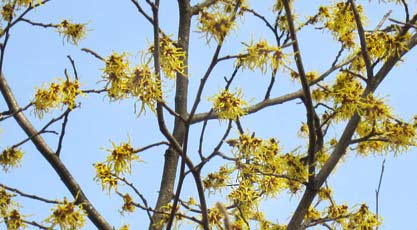 The too soon spring took a break this week. We had some temperatures in the teens followed-up with days in 40s – normal for this time of year. The return of winter browned out the early blooming camellias and the flowering apricot trees that a week ago were flourishing. Unfazed by changes though were the trees and flowers that don’t mind this kind of cold. Around here that’s mostly the witch hazels. They’re in full bloom all around the botanical garden in tints that spread over most of the hot side of the color wheel. The tallest witch hazel in the Garden is this Arnold’s Promise (Hamamellis intermedia) tree blooming in the middle of the English Woodland Garden. It’s just started to bloom so it ought to be the center of attention for a while.  Here’s a before and after - the Camellia japonica ‘Spring’s Promise’ shrub planted in a very sheltered spot in the Kemper Gardens a week ago and again this morning.  Meanwhile on the ground, Winter Aconites have started blooming. I’ve yet to see them open – maybe it’s too early in the morning or the sun isn’t high enough yet. I’ve seen pictures of winter aconites in English gardens that are so thick with plants that from a distance they turn the ground yellow. Nothing approaches that kind of exuberance in this Garden. Here and there there are clumps of blooms, but there’s no concerted effort to make these early-blooming oddities into a not-to-be-missed attraction.
Meanwhile on the ground, Winter Aconites have started blooming. I’ve yet to see them open – maybe it’s too early in the morning or the sun isn’t high enough yet. I’ve seen pictures of winter aconites in English gardens that are so thick with plants that from a distance they turn the ground yellow. Nothing approaches that kind of exuberance in this Garden. Here and there there are clumps of blooms, but there’s no concerted effort to make these early-blooming oddities into a not-to-be-missed attraction.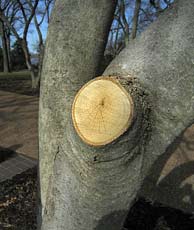 Everywhere shrubs and trees are being pruned, thinned, shaped, and cut. A huge tree in the mausoleum garden was felled a couple of weeks ago. This week at the edge of the Japanese Garden I noticed that some cherry trees and a river birch were gone. All of the tree work is done during the week, so I see just the results not the process. This is a cut that severed a limb from one of the magnolia trees. I look at it – so smooth and clean so surgical – and think it’s time to get my garden tools sharpened or to get some new ones. Everywhere shrubs and trees are being pruned, thinned, shaped, and cut. A huge tree in the mausoleum garden was felled a couple of weeks ago. This week at the edge of the Japanese Garden I noticed that some cherry trees and a river birch were gone. All of the tree work is done during the week, so I see just the results not the process. This is a cut that severed a limb from one of the magnolia trees. I look at it – so smooth and clean so surgical – and think it’s time to get my garden tools sharpened or to get some new ones.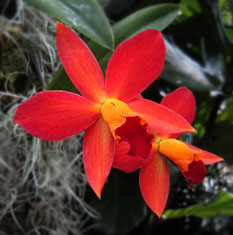 After walking outdoors and then warming up with a cup of coffee, there’s the orchid show. I drop in every week just to walk around. New orchids replace the ones that have peaked so that visitors will always see perfect blooms. I can’t begin to know what’s new and what’s been taken away. Like most people here, I look, admire, and point my camera at my favorite flowers. Today this little one with colors I can’t begin to name stood out for me -- a hybrid cross named Sophrolaeliacattleya Ginny Champion ‘Riverbend.’ After walking outdoors and then warming up with a cup of coffee, there’s the orchid show. I drop in every week just to walk around. New orchids replace the ones that have peaked so that visitors will always see perfect blooms. I can’t begin to know what’s new and what’s been taken away. Like most people here, I look, admire, and point my camera at my favorite flowers. Today this little one with colors I can’t begin to name stood out for me -- a hybrid cross named Sophrolaeliacattleya Ginny Champion ‘Riverbend.’ Who around here doesn’t have a story about the winter that wasn’t – or at least isn’t so far? Last week the newspaper printed a big picture of a field of crocuses blooming in someone’s front yard. On tv there were videos of college students cutting classes to boat in the park and weather forecasters talking about record breaking highs that went back to the 1800’s. There were interviews with peach growers who were alarmed the warm days and nights might push their trees into unseasonable blooms. There are unseasonable things happening at the botanical garden too. But for the fog and mist, this patch of Tommy Crocuses (Crocus tomassinianuss) near the daylily gardens would have been in bloom. 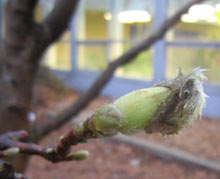 Some of the star magnolia trees closest to buildings and others in more sheltered places have cracked their gray, fuzzy covers. Magnolias don’t seem to be able to patiently wait for spring. They’re deceived by the first string of unseasonably warm days and nights. Often the flowers never survive to see the real spring when it finally does come. Some of the star magnolia trees closest to buildings and others in more sheltered places have cracked their gray, fuzzy covers. Magnolias don’t seem to be able to patiently wait for spring. They’re deceived by the first string of unseasonably warm days and nights. Often the flowers never survive to see the real spring when it finally does come.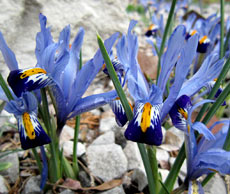 I saw this patch of blue Iris reticulata in full bloom in the rock garden near the Temperate glasshouse. They’re at least a month early – due date according the botanical garden’s website is March to April. Nice thing about these little flowers that don’t venture far from the ground is that when they decide to open, they stay open – cold, rain, and clouds don’t matter to them. Early or later, whenever they open, they’re a delight. I like the way English gardener and writer Beverly Nichols writes about this iris: “If you want a finer flower than this in winter, you had better go and lock yourself up in your greenhouse and sing hymns.” I saw this patch of blue Iris reticulata in full bloom in the rock garden near the Temperate glasshouse. They’re at least a month early – due date according the botanical garden’s website is March to April. Nice thing about these little flowers that don’t venture far from the ground is that when they decide to open, they stay open – cold, rain, and clouds don’t matter to them. Early or later, whenever they open, they’re a delight. I like the way English gardener and writer Beverly Nichols writes about this iris: “If you want a finer flower than this in winter, you had better go and lock yourself up in your greenhouse and sing hymns.”Apart from the blooming things, another thing I noticed this morning was the lack of winter burn on plants that in other years would have been brown. Pachysandra leaves are still bright green and a few flowers are even blooming. The hellebores are beginning to flower too and the leaves that they put on last spring still look healthy. Usually the leaves have turned to brown mush and have to cut down so that the blooms can to show through. 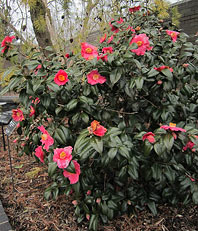 Even the camellia shrubs have passed through the worst part of winter without showing signs of leave drop or damage. Camellia japonica ‘Korean Fire,’ the hardiest of the japonica species, has survived with no injury at all and the buds they put on last fall have started to open. In very sheltered part of the Garden that’s certain to have a microclimate a zone above all the rest of the garden, there’s this Camellia japonica named ‘Spring’s Promise’ that’s in full bloom. Glossy green leaves, bright yellow insides, with rosy flowers as big as a tangerine freely blooming here the Midwest in early February. Even the camellia shrubs have passed through the worst part of winter without showing signs of leave drop or damage. Camellia japonica ‘Korean Fire,’ the hardiest of the japonica species, has survived with no injury at all and the buds they put on last fall have started to open. In very sheltered part of the Garden that’s certain to have a microclimate a zone above all the rest of the garden, there’s this Camellia japonica named ‘Spring’s Promise’ that’s in full bloom. Glossy green leaves, bright yellow insides, with rosy flowers as big as a tangerine freely blooming here the Midwest in early February.The local orchid society is holding its annual show and sale this weekend. Vendors, growers, exhibitors, browsers, buyers, and the curious are packed into narrow aisles separating the tables of orchids for sale from those being judged. The room is buzzing with questions and conversation about orchids. I joined in on an exchange between an orchid club member who was talking with a vendor about what could account for why the sales and popularity of potted orchids is increasing while the membership in orchid societies is dwindling. They both thought it was because orchids have become disposable goods. So If that’s the way they’re seen, they thought, why bother to join a club to learn how to cater to them? When one orchid dies, just throw it out and get another at any drug store, home center, supermarket, or discount store. They also thought that those people who do decide to care for orchids after they finish blooming or even to try their hand at growing them can now get all the information they need online, so why waste time joining a club and going to meetings? As an aside, I decided to check the figures on orchids sales in the United States to see if more orchids were being sold. I found that the wholesale value of potted orchids (the only kind displayed at the show and sale here) rose 80% between 1996 and 2007. Except for poinsettias, orchids are now the second most valuable potted plant sold in the country. Just three states – California, Hawaii, and Florida account for about 90% of the orchids grown in this country. Most of the orchids coming into United States are grown either in Taiwan, which specializes in Phalaenopsis, or Thailand, noted for Dendrobiums. 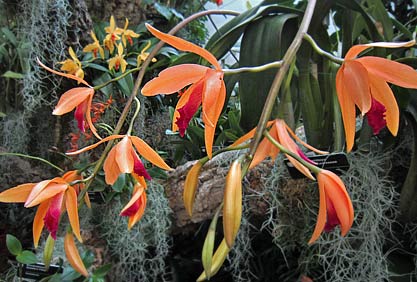 The botanical garden’s annual orchid show opened this morning. The display hall that a month ago was decked out with poinsettias, toy trains, and fir trees (real ones and fake ones) has become a Chinese garden complete with a moon gate as its entrance. The theme for the orchid show changes every year – last year it was Mayan culture, the year before it was the street scenes of Paris, and before that it had a theme that featured characters from children’s stories. Regardless of the theme though, it’s still the orchids that bring in the crowds. The show brochure says that “The Garden cares for one of the world’s premier orchid collections” and that about 800 blooming orchids will rotate in and out of the show before it closes in a couple of months. The orchids that come and go are brought in through a tunnel that leads to the greenhouses where they live most of the year. The immense greenhouses that house the Garden’s nearly 8000 orchids are usually closed to visitors. Each year though there’s a tour for limited number of people, but it’s usually sold out before I ever hear about it. But this year I’ve got a ticket. So next month I’ll get to see where all the orchids live. No doubt -- the Garden’s annual orchid shows always deliver on beauty. Most visitors leave with dozens of pictures of orchids to enjoy as slideshows or screensavers when they get home. Likely though most leave without knowing much more about orchids than when they walked in. As stunning and approachable as the flowers are, orchids as plants seem too complicated to try to deal with. They have names that are tough to pronounce even while sober. They have a reputation of being finicky to grow. And they seem to have cult status that excludes all but the most reverential. Orchids and gourmet food have a lot in common – enjoy them when your out, but never get personally involved with either of them. My sister-in-law always has a beautiful orchid in bloom in her living room. She says that orchids are better and cheaper than cut flowers. An orchid lasts for weeks, sometimes months, so when it finishes blooming, she says she just throws it out as she would a vase of a cut flowers and buys another. She may be on to something. I’ve had a couple of Oncidium orchid plants for three years now. I mist them, water them, and turn their pots most days. One has bloomed twice. The other not at all. With my orchids I feel as I do when I’m playing a slot machine. Even though I’m losing, I keep thinking I can’t stop yet. If I keep misting them and turning them, then maybe tomorrow or the next day a bloom stock will poke out. After a visit to Marie Selby Botanical Garden in Sarasota last week, I started thinking about “temperate bias.” It’s a term invented by Meg Lowman, former CEO of the Selby. She came from the North and brought with her her expectations of how plants ought to act – they flower mostly in the summer, they drop their leaves in the fall, and then they hibernate in the winter. She put all that aside when she studied the life cycle of leaves on topical plants and the year round vibrancy of activity in the canopy of the rainforests. In the botanical garden where I walk, I’ve avoided visiting the Climatron, the glass geodesic dome that houses the Garden’s collection of tropical plants. I thought the plants were too strange. They were the kinds of things I’d never encounter outdoors so why bother with them. They’re like caged zoo animals kept alive only to titillate visitors. Temperate bias, me thinks. In that glasshouse are some of the plants that inhabit the most bioactive part of the world -- the areas where the future of the planet may get played out. Maybe more attention needs to be paid. 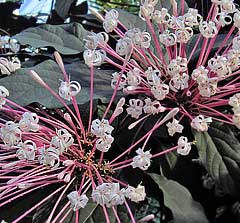 I’ll start shedding my temperate bias modestly by starting with flowering plants in the Climatron. Here’s Clerodendrum quadriloculare -- a shrub that flowers in the winter early months of the year. For obvious reasons it’s nick named winter starburst, shooting star, and fireworks for its allium-like spread of flowers that span about ten inches across. I’ll start shedding my temperate bias modestly by starting with flowering plants in the Climatron. Here’s Clerodendrum quadriloculare -- a shrub that flowers in the winter early months of the year. For obvious reasons it’s nick named winter starburst, shooting star, and fireworks for its allium-like spread of flowers that span about ten inches across.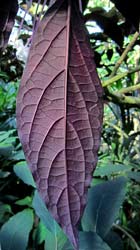 The marker in front of the ten-foot shrub says the Clerodendrum is a native of the Philippines and New Guinea, but I noticed that many garden centers in South Florida stock it. Top Tropicals in Fort Myers says, “It’s a true ‘Show Stopper’ as passers-by will marvel at this explosion of tropical beauty. Tourists especially like to have their pictures taken standing next to this colorful tropical tree.” Apart from its blooms (which look as though they ought to be fragrant, but aren’t) I think the most unusual thing about the shrub is its leaves – green on the side that’s seen and deep purple on the reverse. Blooming is reported to last six to eight weeks, but since I just spotted it this morning I’m not sure when it started flowering. The marker in front of the ten-foot shrub says the Clerodendrum is a native of the Philippines and New Guinea, but I noticed that many garden centers in South Florida stock it. Top Tropicals in Fort Myers says, “It’s a true ‘Show Stopper’ as passers-by will marvel at this explosion of tropical beauty. Tourists especially like to have their pictures taken standing next to this colorful tropical tree.” Apart from its blooms (which look as though they ought to be fragrant, but aren’t) I think the most unusual thing about the shrub is its leaves – green on the side that’s seen and deep purple on the reverse. Blooming is reported to last six to eight weeks, but since I just spotted it this morning I’m not sure when it started flowering. I first read about the Marie Selby Botanical Garden in 2003. Newspapers and blogs were brimming with stories about the intrigue that began when a collector just back from Peru walked into the Garden carrying with him an orchid that needed identification. The excitement began when Selby’s orchid experts announced with pride and considerable media flourish that the orchid was a new, undiscovered specie. That announcement led to questions about whether the rare and endangered orchid had been obtained legally and whether it had entered the country legally. Under the Endangered Species Act, the federal government and the courts soon got involved. The story ended in 2004 when the collector who brought the orchid to Selby for identification got two years of probation was fined $1,000 for bringing the orchid into the country, and the Marie Selby Botanical Garden was indicted for how it handled the rare undocumented orchid. The Garden pleaded guilty, paid a $5,000 fine, and received three years of probation. The furor stirred up by that one orchid led to board resignations, loss of professional staff, firing of Selby’s internationally respected executive director, and a loss of nearly $400,000 in pledged support to the Garden. Since the orchid mess, Selby pared its mission statement way down. Before 2000 the small Garden had big plans: “to passionately pursue knowledge about tropical plants and their habitats and to apply that expertise to advance their conservation and display.” Now the Garden has more modest ambitions. It first wants to “to further the understanding and appreciation of plant life, with emphasis on epiphytes” And then to “to provide enjoyment to all who visit the Gardens.” That’s it – learn more about epiphytes and try to make sure that people who visit the Garden have a good time. Perhaps modesty fits. When stacked up against the big names in botanical gardens, Marie Selby in Sarasota, Florida is small. It’s sandwiched into a cramped space between a city street and the bay -- originally just 7 acres and now still only 14. On a good day at the height of the tourist season, the Garden might draw close to 400 visitors, but 200 is more typical. Just 9 horticulturists look after its plantings and only 4 researchers are on the Garden’s payroll. The Garden’s annual budget of $3.4M is small potatoes compared to the New York’s Botanical Garden’s $61M or the Missouri Botanical Garden’s $44M. There’s another side though. Selby now has more than 10,000 members. It has 600 volunteers too. The New York Botanical Garden, biggest best financed Botanical Garden in country, has just 800. When we visited Selby, a volunteer sold us our tickets and encouraged us to watch a video about the Garden while we waited for the next volunteer-led tour of the garden. After getting our ticket we were sent to a desk where another volunteer gave us a map of the Garden, circled the must-see spots, and again reminded us to wait for the next volunteer-led walking tour. People here seem proud and protective of their Garden and they seem passionate that visitors learn about it and see everything they can when they visit. We joined a walking tour just as it was beginning. After telling us how Marie and William Selby’s longtime home and grounds became the Marie Selby Botanical Gardens, our guide, Mary, told us about epiphytes. She said that before the Garden opened in 1975, consultants from the New York Botanical Garden and University of Florida were called in to help determine what could make the Selby Garden unique among the 200 or more botanical gardens in the country. Epiphytes, they said. Epiphytes it eventually became. Mary began by telling us that an epiphyte was a plant that grew on another plant but didn’t depend on the other plant for its nourishment. She pointed to the Spanish Moss hanging from one of the nearby oaks as an example. She told us that tree companies in Florida make a lot of money removing Spanish Moss from lawn trees because home owners think the moss is choking the tree. Who knew – the moss is there she said because it’s opportunistically attaching itself to an already ailing tree because it gets more light that way. 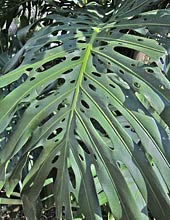 Then Mary brought us over to a philodendron that was climbing up a pergola. It’s a epiphyte too, she pointed out. The small ones usually sold as house plants have one type of leaf – heart-shaped and full. Outdoors, given free rein they have fully shaped leaves near the ground. Then as the vines climb, their leaves begin to look like Swiss cheese and sometimes they develop deeply indented margins. She said the holes and indentations let the wind can pass thorough without tearing the leaves. Before finishing, Mary showed us a pineapple, a group of staghorn ferns mounted on some palms, some rose-colored rosettes on a patch of bromeliads, and an orchid or two – all epiphytes, she said. Then Mary brought us over to a philodendron that was climbing up a pergola. It’s a epiphyte too, she pointed out. The small ones usually sold as house plants have one type of leaf – heart-shaped and full. Outdoors, given free rein they have fully shaped leaves near the ground. Then as the vines climb, their leaves begin to look like Swiss cheese and sometimes they develop deeply indented margins. She said the holes and indentations let the wind can pass thorough without tearing the leaves. Before finishing, Mary showed us a pineapple, a group of staghorn ferns mounted on some palms, some rose-colored rosettes on a patch of bromeliads, and an orchid or two – all epiphytes, she said.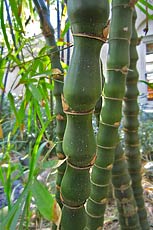 Before turning us loose to see the rest of the garden Mary pointed out the Garden’s extensive collection of clumping bamboo. Two I remember were Golden Hedge bamboo with its yellow canes stripped with green and the Dwarf Buddha’s Belly (Bambusa vulgaris ‘Wamin’), a dark green bamboo that bulges out between growth nodes. Before turning us loose to see the rest of the garden Mary pointed out the Garden’s extensive collection of clumping bamboo. Two I remember were Golden Hedge bamboo with its yellow canes stripped with green and the Dwarf Buddha’s Belly (Bambusa vulgaris ‘Wamin’), a dark green bamboo that bulges out between growth nodes.Finally, there was the Garden’s centerpiece – a grove of Banyan trees (Ficus benghalensis) that was planted by the Selby’s in the 1930’s. 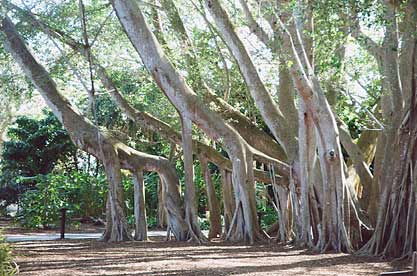 This native fig of India spreads over wider andwider areas by dropping spaghetti-like tendrils from its branches. When the tendrils reach the ground they take root and grow into pillars called prop branches that support the outward growth of the main branches. Supposedly Alexander the Great’s entire 7000-man army was able to camp under a single Banyan tree in India. Mary told us that because of the Banyan’s space-grabbing habit, they are considered invasive and illegal to plant in some parts of Florida. Another of Selby’s must-see trees is the Bo Tree (Ficus religiosa) growing near Sarasota Bay.  This is another Asian tree. My plant encyclopedia Flora says it’s also called the Sacred Fig. Tradition has it that Buddha attained enlightenment while meditating under a Bo Tree. Since then it’s been regarded as sacred tree and is planted near many Buddhist temples. Here in Sarasota many marriage ceremonies have been performed under the Bo. A sign near the tree said that it was toppled by a tropical storm that hit in 2001 a few days after 9/11. But with the help of a crane on a barge and many volunteers, the tree was righted, trimmed, and replanted. It survives. 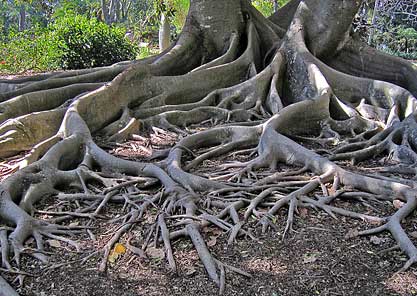 Still another fig tree – the Moreton Bay Fig (Ficus macrophylla). This one is a native of Australia. Instead of aerial roots, this fig has buttress roots that fan out from the trunk. The nearby sign calls them “octopus roots” and says they can grow 15 feet high if needed to support the tree.  The most eye-catching tree at Selby this morning was this Red Silk Cotton Tree (Bombax ceiba). Not a leaf on the tree. Just these huge hibiscus-colored flowers blooming high in the canopy. The silk tree had just started to flower, but even so the blooms that had opened stood out against the sky. The most eye-catching tree at Selby this morning was this Red Silk Cotton Tree (Bombax ceiba). Not a leaf on the tree. Just these huge hibiscus-colored flowers blooming high in the canopy. The silk tree had just started to flower, but even so the blooms that had opened stood out against the sky.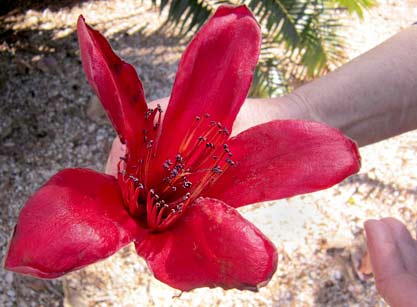 We found this blossom on the ground. The petals reminded me of an over-sized magnolia; the erect cluster of stamens in the center was camellia-like. I wish I could see the tree in full bloom and then come back again later in the year to see what kind of fruit these giant flowers give way to.  Apart from the plants, the best reason for going to Selby Botanical Garden is to take in the view. Sit or stand at the point near the Bo tree and look across the blue bay waters to the Ringling Causeway or East to downtown Sarasota. If you’re looking for a spot to take a picture to send home, this would be it. 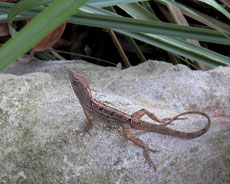 Except for a few egrets, a heron, and a brown pelican hovering over the water, we didn’t see many birds at the Garden. On land, there were a few squirrels but lots of these lizards called Brown or Cuban Anoles. A sign describing the anoles says they flash their orange dewlaps to attract a mate or to defend their territory. Like chameleons, anoles are supposed to able to change their color, but all the ones we saw just stayed brown.
Except for a few egrets, a heron, and a brown pelican hovering over the water, we didn’t see many birds at the Garden. On land, there were a few squirrels but lots of these lizards called Brown or Cuban Anoles. A sign describing the anoles says they flash their orange dewlaps to attract a mate or to defend their territory. Like chameleons, anoles are supposed to able to change their color, but all the ones we saw just stayed brown.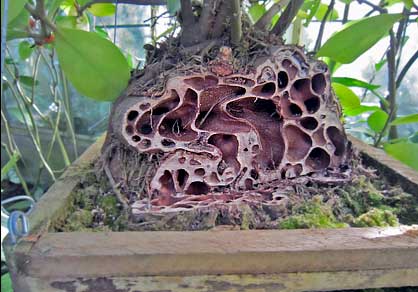 Finally, here’s a strange epiphyte that we saw in the green house that houses much of the Garden’s orchid collection – its label says it’s a Hydnophytum. We knew a little about it – the Ant Plant - because it was featured in a video we watched when we came into the Garden.  The engorged stem of the plant has been sliced open to show the tunnels and passageways inside. Ants form colonies in the lacey insides of the hydnophytum. The plant benefits because ants defend it from flesh-eating predators and leave waste behind that the plant finds nutritious. In return the ants have a secure place to live and breed. The plant at Selby is probably no bigger that a softball, but I’ve read that they can grow as large as a football in the tropical forests of Northern Australia and Indonesia. I’m thinking the hydnophytum (sans ants) would make a great addition to a terrarium. The engorged stem of the plant has been sliced open to show the tunnels and passageways inside. Ants form colonies in the lacey insides of the hydnophytum. The plant benefits because ants defend it from flesh-eating predators and leave waste behind that the plant finds nutritious. In return the ants have a secure place to live and breed. The plant at Selby is probably no bigger that a softball, but I’ve read that they can grow as large as a football in the tropical forests of Northern Australia and Indonesia. I’m thinking the hydnophytum (sans ants) would make a great addition to a terrarium.Click here to see a slideshow of more of the pictures we took at Selby. 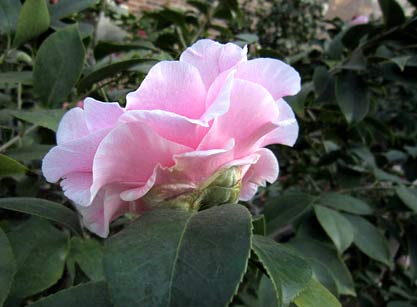 I’ve heard them described as “the roses of winter.” Camellias, the big-flowered japonica types, finally have started to bloom in the Linnaean glasshouse. This is their first season back home after spending last winter in storage while the glasshouse was being renovated. The botanical garden’s collection of camellias has been halved since a renovation converted the south side of the glasshouse into an orangery for subtropicals. The photo above is Camellia japonica ‘C. M. Wilson,’ one of some 2000 named varieties of japonicas. C. M. Wilson was registered more than 60 years ago and this botanical garden has two specimens planted here. Like C. M. Wilson, most of the japonicas blooming here are velvety, lush, and tempting to touch and smell. To help imagine that all of these fragrance-free camellias really smell as pretty as they look, the keepers of glasshouse have planted olive trees, a mix of citrus trees, and a bower of pink jasmine – all meant to help the illusion along. I’d never heard the word “floriferous” until I started planting amaryllis bulbs indoors. Now after a dozen years of buying, planting, and watching them flower I’ve added both floriferous and floriferousness to my vocabulary. Amaryllis bulbs are easy to grow and the payoff is always impressive. This morning I was glad to see that keepers of camellia glasshouse had sunk over a hundred pots of different varieties of amaryllis into the soil near the camellia trees. Until today, I didn’t even know there were that many different varieties of amaryllis. My bulb source, McClure and Zimmerman, lists about 40 varieties. From my experience in growing amaryllis I think the ones in the glasshouse will begin flowering just as the camellias finish. The mix of whites, pinks, cherry reds, salmons, magentas and candy-stripped blooms ought to be spectacular. Also since the pots have been planted so near the walkway, visitors will get a close-up look at the flowers. I predict a lot of posting on Flickr next month. I hope this kind of mass planting of amaryllis will become a new winter tradition here. 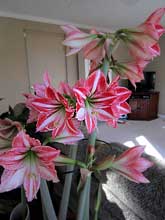 Until I too begin to take photos of the amaryllis beds in the glasshouse, here’s a picture of an amaryllis I have blooming now. It’s named ‘Fairytale.’ McClure and Zimmerman describe it as a miniature hybrid amaryllis with candy-cane blooms, white with raspberry-red stripes and white mid-veins that’s very floriferous. I routinely get three stocks per bulb with six flowers per stock. Until I too begin to take photos of the amaryllis beds in the glasshouse, here’s a picture of an amaryllis I have blooming now. It’s named ‘Fairytale.’ McClure and Zimmerman describe it as a miniature hybrid amaryllis with candy-cane blooms, white with raspberry-red stripes and white mid-veins that’s very floriferous. I routinely get three stocks per bulb with six flowers per stock.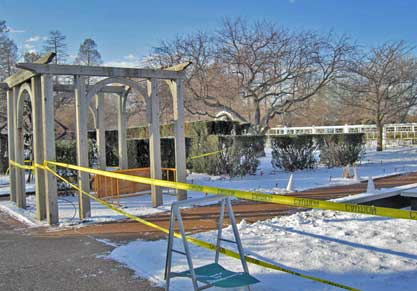 As in years past, January is fix-up time for the garden. The newly-installed insulated glass panels covering the entrance hall to the garden are being repaired. The main restaurant has been closed for renovation. Outside, the biggest project is the dismantling (and I hope replacement) of a massive I-shaped pergola that covered two walkways and a pond. The pergola had been repaired several times before, but wood rot continues to reappear. With the Garden’s new emphasis on sustainability and reuse of old materials, I’m betting that when a new pergola is build, it will be built with composite timber. 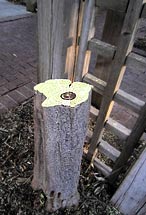 What will take longer to replace than the uprights and the cross-ties will be the old established vines that climbed the old pergola. There were hops and autumn clematis vines along with one standout – the Chinese wisteria (Wisteria sinensis). Over the years, I’ve taken many pictures of this wisteria in full bloom against a backdrop of blue sky and I’ve taken still more of the seeds spread like small round tokens on the walks under the vines. Just a month ago, I’ve stroked the vine’s empty velvety pods that had fallen. This morning I took yet another picture of the wisteria vine – the last one. What will take longer to replace than the uprights and the cross-ties will be the old established vines that climbed the old pergola. There were hops and autumn clematis vines along with one standout – the Chinese wisteria (Wisteria sinensis). Over the years, I’ve taken many pictures of this wisteria in full bloom against a backdrop of blue sky and I’ve taken still more of the seeds spread like small round tokens on the walks under the vines. Just a month ago, I’ve stroked the vine’s empty velvety pods that had fallen. This morning I took yet another picture of the wisteria vine – the last one.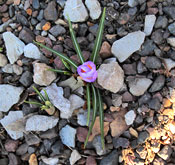 Until the snowfall and cold temperatures of the past week, the winter had been unseasonably warm. Local TV news anchors made a habit of segueing to their weather forecasters by asking, Where has winter gone this year?” Here at this botanical garden I’ve already seen a colony of snowdrops in bloom in the Mausoleum Garden, a white-flowering Japanese apricot blooming in the Chinese Garden, and lots of later blooming witch hazels that have gotten off to an early start. Last week in a sheltered spot in the south facing rock garden, I saw this pale lavender crocus trying to bloom. The peak bloom time for crocuses here is mid-March. Before this year, the earliest reported sighting was the last week in February. Until the snowfall and cold temperatures of the past week, the winter had been unseasonably warm. Local TV news anchors made a habit of segueing to their weather forecasters by asking, Where has winter gone this year?” Here at this botanical garden I’ve already seen a colony of snowdrops in bloom in the Mausoleum Garden, a white-flowering Japanese apricot blooming in the Chinese Garden, and lots of later blooming witch hazels that have gotten off to an early start. Last week in a sheltered spot in the south facing rock garden, I saw this pale lavender crocus trying to bloom. The peak bloom time for crocuses here is mid-March. Before this year, the earliest reported sighting was the last week in February.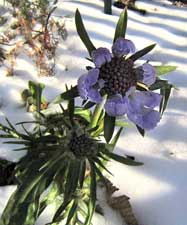 This morning in the Herb Garden, near a walkway that gets radiated heat for the brick edging, I saw this lavender pincushion flower (Scabiosa atropurpurea) in bloom. Like the crocus, the bloom is feeble, the color faded, but after all it’s still the middle of January here in Zone 6. This morning in the Herb Garden, near a walkway that gets radiated heat for the brick edging, I saw this lavender pincushion flower (Scabiosa atropurpurea) in bloom. Like the crocus, the bloom is feeble, the color faded, but after all it’s still the middle of January here in Zone 6. |
||||||||||||||||||||||||||||||||||||||||||
|
+ Click to Subscribe
 | E-Mail me | E-Mail me |
|||||||||||||||||||||||||||||||||||||||||||